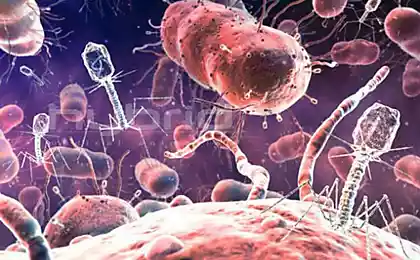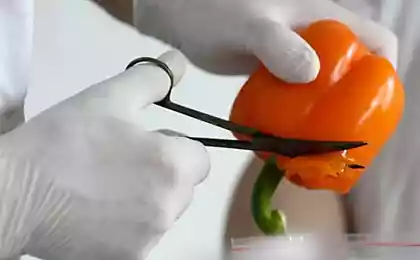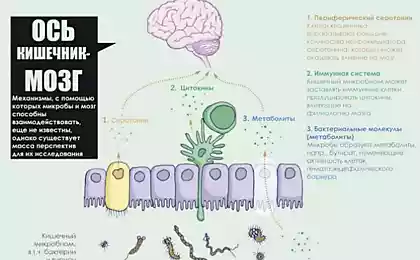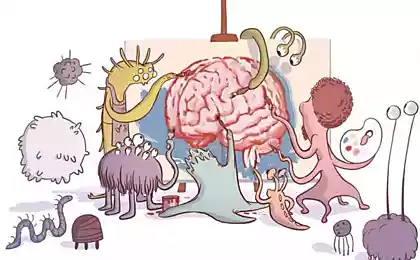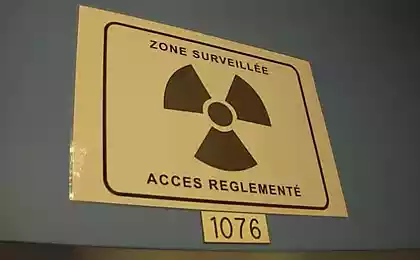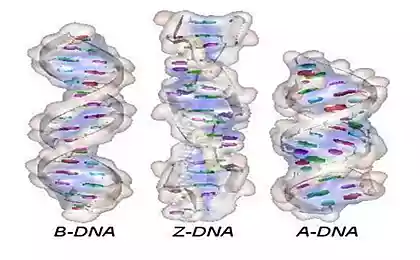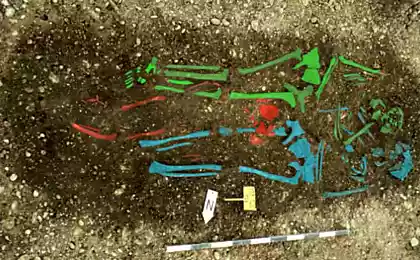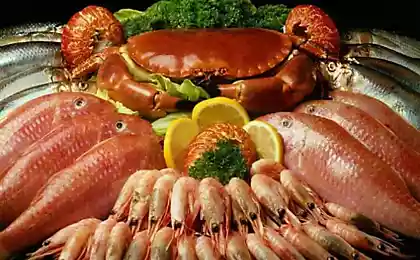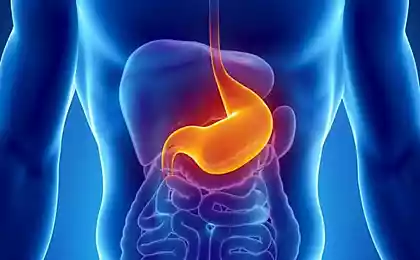876
E. coli "E. coli" to attack Europe
Not in vain, oh, is not in vain in Europe cucumber iznichtozhayut ... ((
Source dangerous E. coli outbreak of E. coli in Europe, due to the deaths of twenty-two and sickened more than two thousand, two hundred, are still not known. German authorities initially blamed for all cucumbers grown in Spain, causing outrage among Spanish farmers. Farmers say they have lost millions of dollars because of falling demand. Studies have shown that Spanish cucumbers did not contain a dangerous strain. Pulses from a farm in Germany are currently undergoing investigation, although the first results were negative. Cases have been recorded in at least ten countries over six hundred people worldwide are in intensive care.
30 photos from here
1.Fotografiya obtained with an electron microscope at the Helmholtz Centre for Infection Research in Braunschweig, shows bacteria EHEC (enterohaemorrhagic E. coli bacteria). German health authorities have yet May 25, 2011 warned consumers about the need to be careful with raw vegetables, especially those grown in northern Germany, after reports of 140 cases of the disease and at least four deaths.
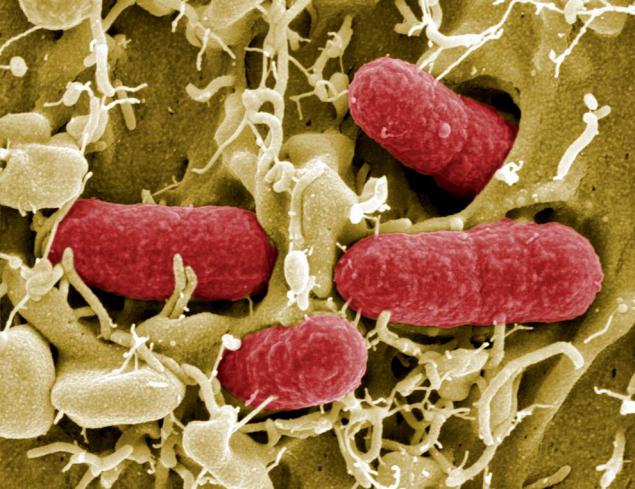
2. The nurse caring for patients infected with virulent bacteria of E.coli and undergoing dialysis in the intensive care University Hospital UKE Hamburg, June 1, 2011. The number of people affected by a mysterious killer bacteria continues to grow, with the beginning of the epidemic had passed two weeks. Concerns about the content of the dangerous strain in vegetables hit European farmers. Scientists and health officials say they have identified the bacterium E.coli, which is responsible for the outbreak of disease, most affected because of which come from northern Germany, but could not say what caused the emergence of these bacteria, or who is responsible for what is happening .
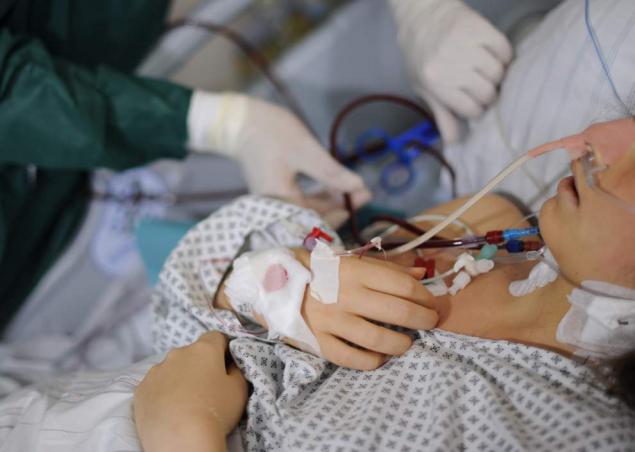
3.Fermer throws crop of cucumbers after they became impossible to sell in El Ejido, near Almeria in the south-east of Spain, June 1, 2011. Spanish farmers claim that their losses have reached 285sillionov dollars a week, and as a result 70,000 people in the country may be left without a job, despite the fact that Spain already has the highest unemployment rate in the European Union.
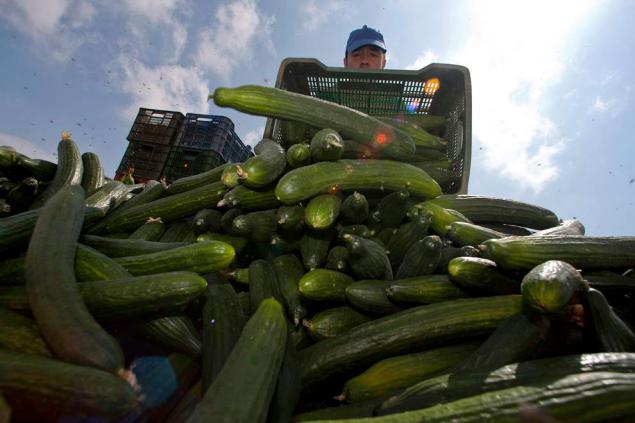
4.Sotrudniki Berlin's Robert Koch Institute wear protective clothing, as they explore the organic compounds that have been identified as a possible source of the deadly E. coli outbreak in the village of E. Coli Binnenbuettel about three hundred kilometers to the north-west of Berlin June 6, 2011. Source of bacteria killer remains unknown. June 6 Germany reported that the initial results of the studies were negative pulses. Meanwhile, the number of deaths has risen to twenty-three. About two thousand people have died of the disease across Europe as a result of the outbreak of enterohaemorrhagic Escherichia coli, which is fixed in twelve countries.
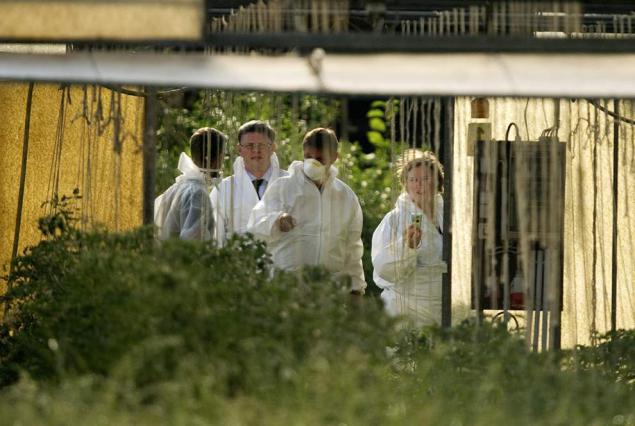
5.Upakovki containing bean sprouts, which are suspected presence of a strain of E. coli, are on the bench Regional Office for Consumer Protection and Food Safety in Oldenburg, Germany, June 6, 2011. Initial test results were negative.
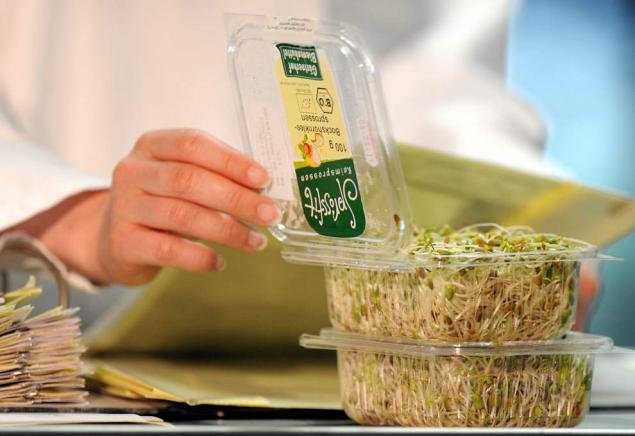
6. Protesting farmers poured about seven hundred pounds of fruits and vegetables, cabbage, tomatoes, peppers, cucumbers and other products under the walls of the German consulate in Valencia, Spain, June 2, 2011. Spain says it does not exclude the possibility of filing a lawsuit against the German authorities, who have accused Spanish vegetables that they have caused outbreaks of E.coli, as a result of which killed sixteen people.
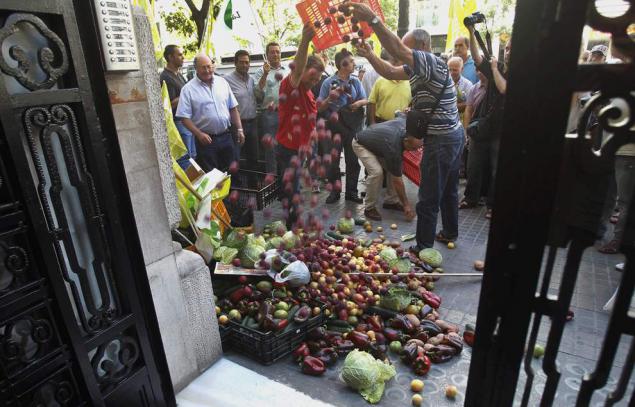
7. Bartolome Florida, president of the association in defense of Andalusian products "Yo? Producto Andaluz! "Smokes a cigarette during a campaign to promote the consumption of cucumbers in Benalmadena, near Malaga, Spain June 3, 2011. Germany would consider measures to compensate Spanish farmers for the decline in sales of vegetables, which followed the outbreak of E. coli, says a statement of the presidential administration in Spain, released on Thursday. Spain face legal action and wants compensation for damage caused to farmers who claim that the losses amounted to 290 million dollars a week.
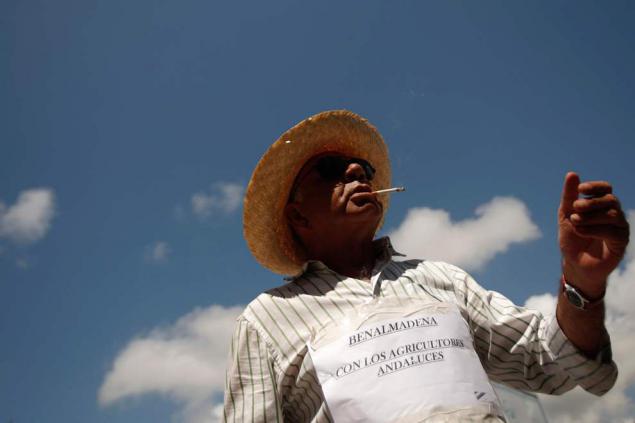
8. People eat cucumber slices during the campaign, which is held in support of the Association Andalusian products "Yo? Producto Andaluz! "To promote the consumption of fruit in Benalmadena, near Malaga in southern Spain, June 3, 2011.
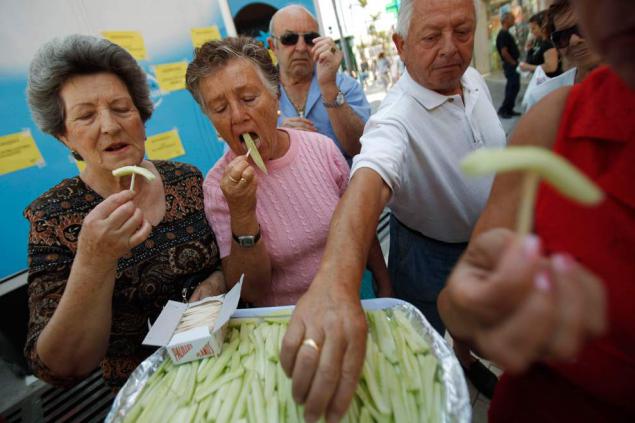
9. People are sitting in a restaurant in front of a poster with the words "As a precaution, we do not use cucumbers, tomatoes and lettuce," in Luebeck, Germany, June 4, 2011.
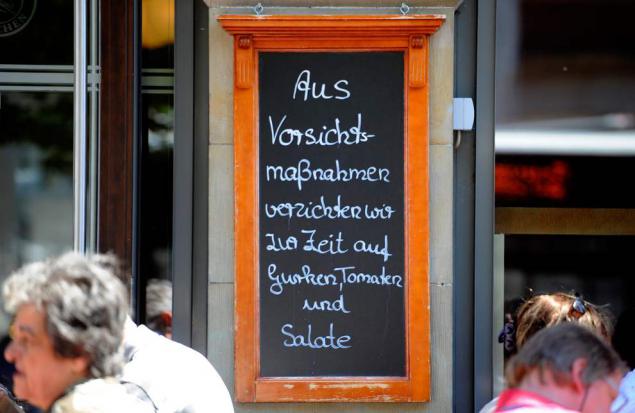
10. The German Health Minister Daniel Bahr in a protective mask insulator attends University Hospital Eppendorf in Hamburg, June 5, 2011. German hospitals are struggling to cope with the flow of the victims of E.coli, Daniel Bahr said on Sunday. Scientists can not find the cause of a deadly virus that has killed nineteen people and sent to hospital beds 1,700 people across Europe.
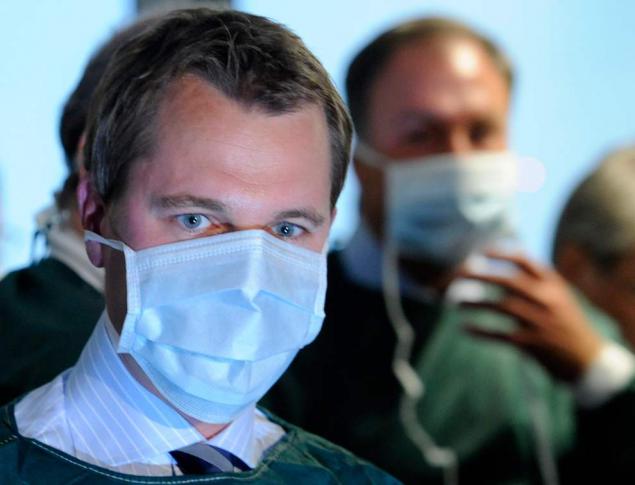
11. A nurse helps an individual to donate blood at the hospital of the German Red Cross in Berlin on June 6, 2011.
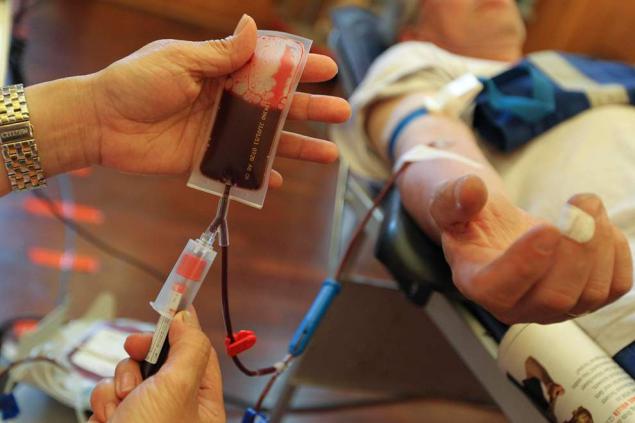
12. A farmer destroys lettuce in a field in Ronnenburge near Hanover, Germany, 27 May 2011.
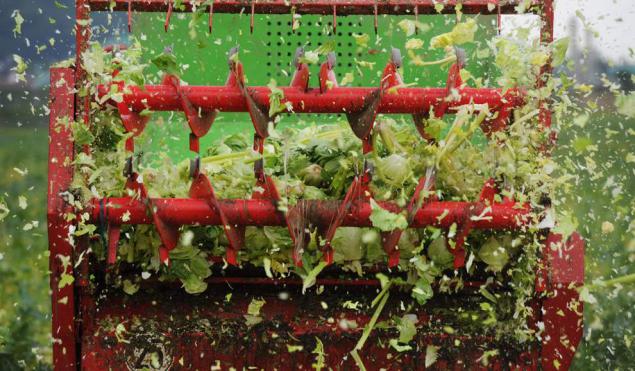
13. A man walks past graffiti on a wall of the German multinational supermarket chain Lidl in Roquetas del Mar, Spain, June 3, 2011. Graffiti reads: "Do not buy anything here! Declare a boycott of Lidl ".

14. Caroline Zeinche, suffered from E. coli E. coli, in the hospital Asklepios Hamburg-Altona, gives interview with Associated Press in Hamburg, Germany, June 6, 2011. Doctors in the hospital Asklepios started to treat patients with E. coli methods of alternative therapies including antibiotics and antibodies, despite warnings by the WHO and the German government.
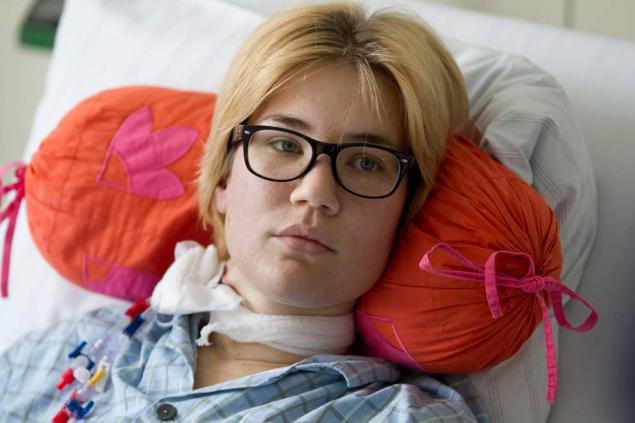
15. A farmer walks past discarded cucumbers and tomatoes near Almeria in the southeast of Spain 1 June 2011.
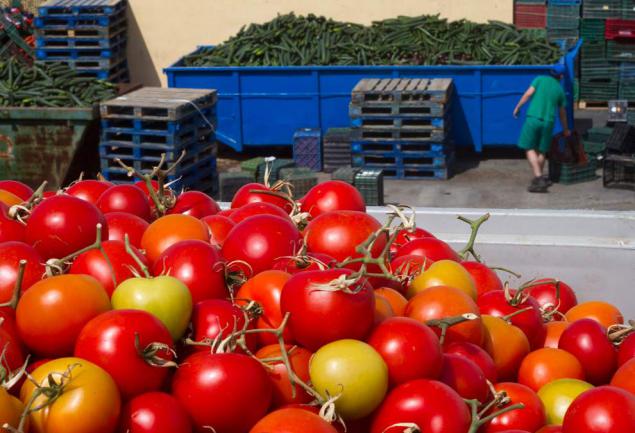
16. The Deputy Prime Minister Alfredo Perez Rubalcaba of Spain (right) next to the Andalusian regional president Jose Antonio Grinanom during a press conference concerning the outbreak of the infection of the bacteria E.coli, Almeria 1 June 2011.
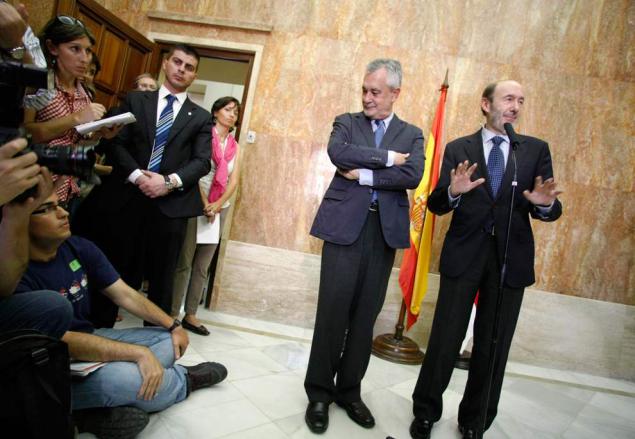
17. Farmer throws crop of cucumbers in El Ejido, near Almeria in the south-east of Spain, 31 May 2011. Spain said on Monday that there was no evidence that it was Spanish cucumbers caused the outbreak E.coli in Germany, due to the deaths of 14 people. E. coli linked to contaminated cucumbers that led to the disease in more than three hundred people in Germany.
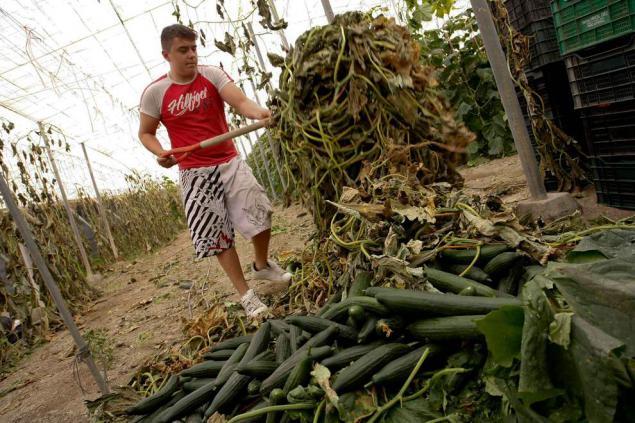
18. Farmer Tobias Haack kills nearly 10,000 bushes salad on one of its fields of June 4, 2011 near Hamburg, Germany. Farmers in northern Germany in crisis because of the outbreak of E. coli vegetables actually ceased to be sold. Haak says he usually sells a thousand boxes of lettuce a day, although it currently sells about forty. "I hope that they will not leave us in such a state," he said of the German government, and believes that the decision to enter the low-interest loans for affected farmers, is useless. He said that if the crisis continues, it will face serious financial problems within two to three weeks.
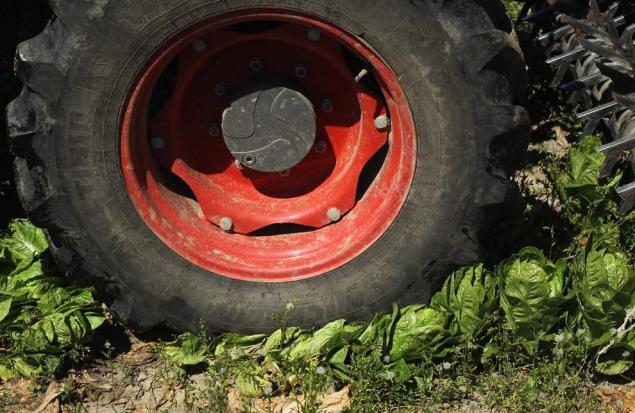
19. A worker arranges boxes of melons, which are in connection with the breakdown of orders remained at the warehouse in El Ejido, near Almeria in the south-east of Spain, 31 May 2011. Farms in the southern Spanish province of Andalusia lose ten to twelve million dollars a day.
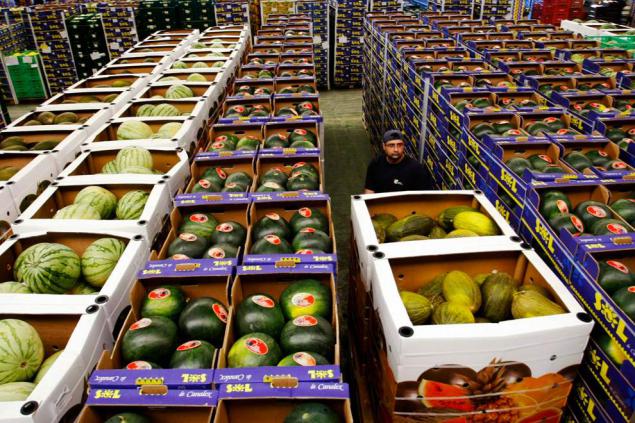
20 patients suffering from hemolytic-uremic syndrome, a complication that can lead to kidney failure, convulsions and epileptic seizures and is caused by enterohaemorrhagic Escherichia coli, also known as EHEC, lying in bed in the Nephrology Unit at the University Medical Center Hamburg-Eppendorf June 2 2011 in Hamburg, Germany. The German authorities have reported that initial suspicions about cucumbers from Spain are unfounded, but they still warn against the consumption of raw vegetables. University Medical Center provides treatment of a large number of patients infected with EHEC.
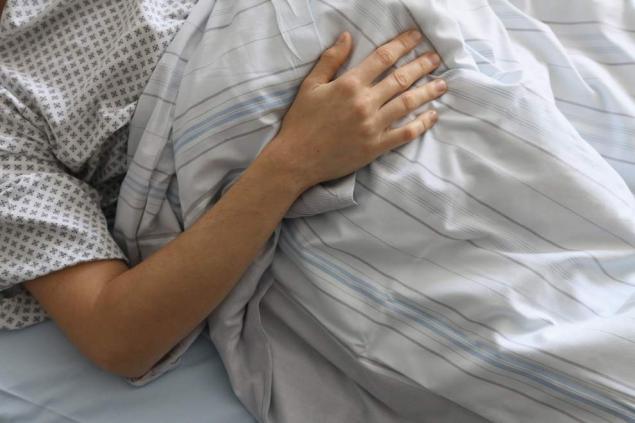
21. Dr. Stefan Kluge, head of intensive care at the University Hospital Hamburg-Eppendorf, speaks to journalists at a press conference on the outbreak of EHEC June 2, 2011 in Hamburg.

22. EHEC bacteria are seen in the photo provided by the research center of the Helmholtz Infectious Diseases May 30, 2011, Berlin.
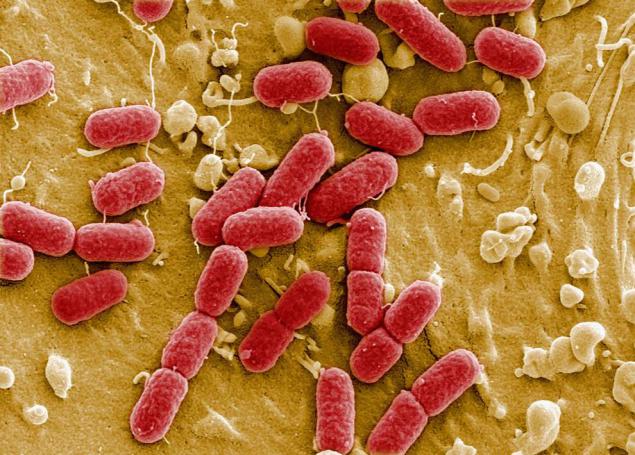
23. radish shoots are shown in pack of 6 June 2011 in Berlin. The German authorities have conducted studies across sprouted seedlings, suspected that it is the source of E. coli outbreak due to the deaths of twenty-two and went to the hospital about two thousand people across Europe. Initial studies have shown that pollution is a seedling of lettuce, azuki beans, mung peas, fenugreek, alfalfa and lentils. Some seeds were imported from abroad.
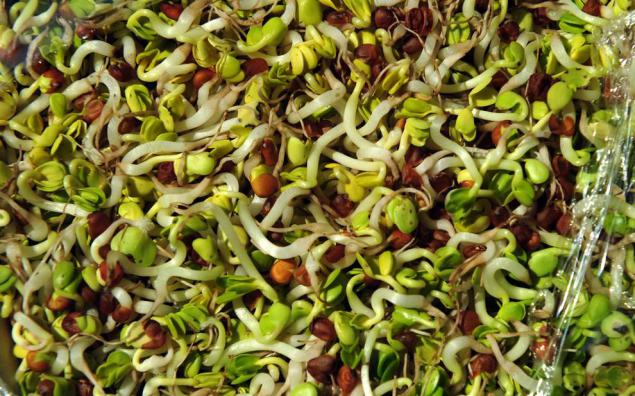
24. Close the farm Gaertnerhof Bienenbuettel June 6, 2011, in Binnenbuettel, Germany. Health authorities in Germany and the territory of Lower Saxony closed the farm the day before on suspicion that sprouts, which are grown here can be a source of enterohaemorrhagic Escherichia coli, also known as EHEC.

25. Cucumbers are scattered on the field, they will be used as fertilizer French farmers who can not sell their products in Carquefou near Nantes, France, June 6, 2011.
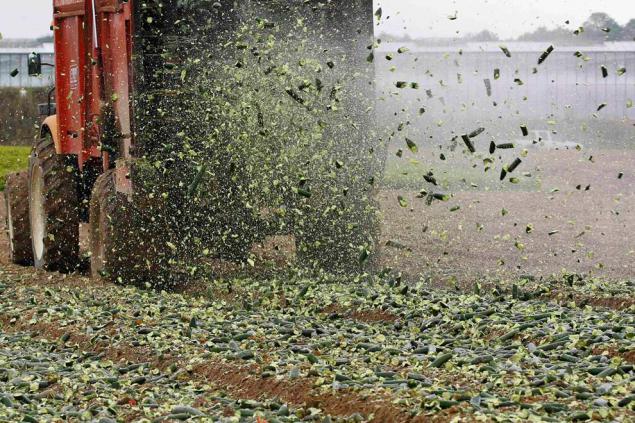
26. A member of the Czech center of national reference laboratories prepares samples of vegetables for molecular testing for bacteria EHEC (coliform bacteria) in Brno June 1, 2011. Samples of vegetables that are imported from different countries, are tested for E. Coli in the laboratory.
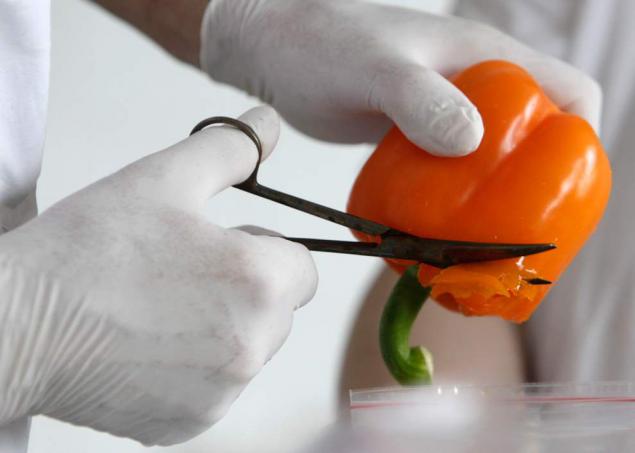
27. Agricultural worker empties cucumbers into the container in order to use them as fertilizer in a field in Carquefou, France, June 6, 2011. The current crisis is the deadliest E. coli epidemic in modern history, and in a flash accuse extremely aggressive, "super-toxic" strain of E. coli.
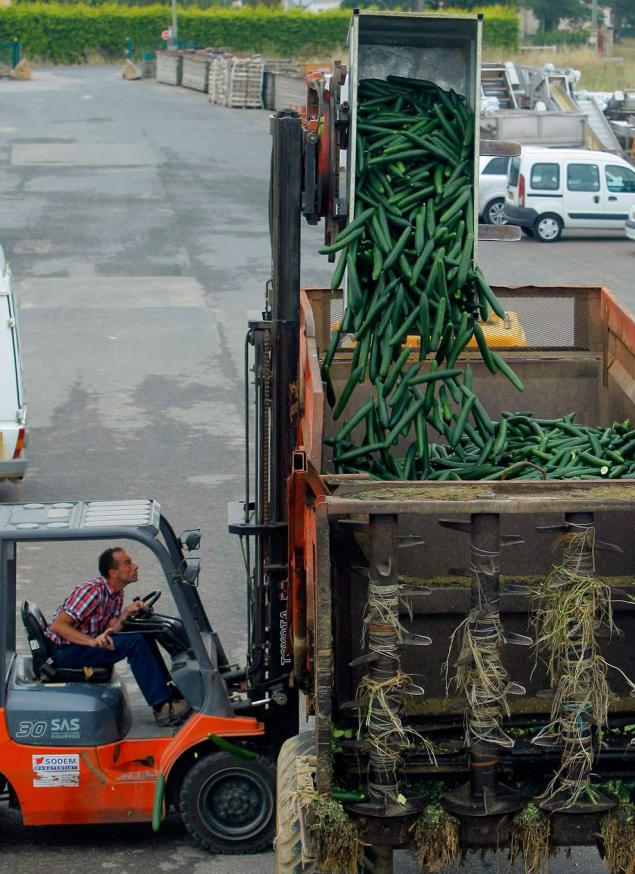
28. Laboratory is looking for strains of E.coli bacteria in plant cells placed in a petri dish, in La Moyonera near Almeria in the southeast of Spain on 2 June 2011.
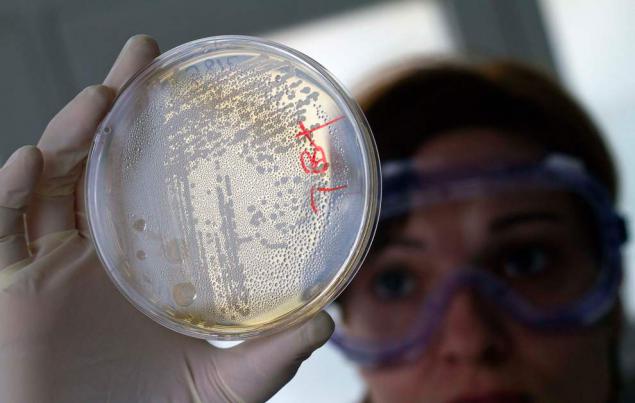
29. A man carries cucumbers for the destruction of the farm under Bucharest, Romania, June 6, 2011. Producers destroyed thousands of tons of cucumbers over the past two days, local media reported.
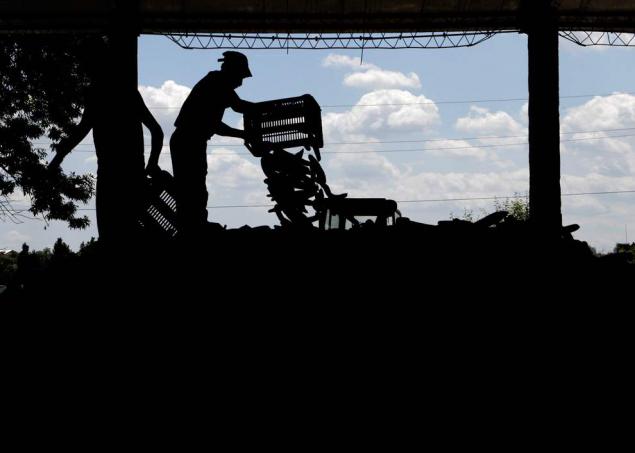
30. Dr. Hauke Veylert checks drip patient affected by E. coli during kidney dialysis in the hospital Asklepios Hamburg-Altona, Germany, June 6, 2011.
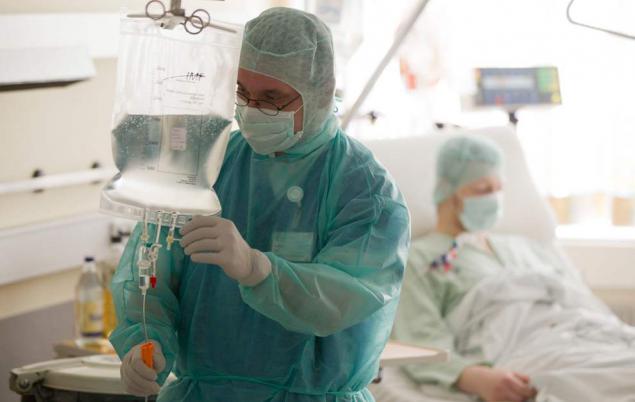
Source:
Source dangerous E. coli outbreak of E. coli in Europe, due to the deaths of twenty-two and sickened more than two thousand, two hundred, are still not known. German authorities initially blamed for all cucumbers grown in Spain, causing outrage among Spanish farmers. Farmers say they have lost millions of dollars because of falling demand. Studies have shown that Spanish cucumbers did not contain a dangerous strain. Pulses from a farm in Germany are currently undergoing investigation, although the first results were negative. Cases have been recorded in at least ten countries over six hundred people worldwide are in intensive care.
30 photos from here
1.Fotografiya obtained with an electron microscope at the Helmholtz Centre for Infection Research in Braunschweig, shows bacteria EHEC (enterohaemorrhagic E. coli bacteria). German health authorities have yet May 25, 2011 warned consumers about the need to be careful with raw vegetables, especially those grown in northern Germany, after reports of 140 cases of the disease and at least four deaths.

2. The nurse caring for patients infected with virulent bacteria of E.coli and undergoing dialysis in the intensive care University Hospital UKE Hamburg, June 1, 2011. The number of people affected by a mysterious killer bacteria continues to grow, with the beginning of the epidemic had passed two weeks. Concerns about the content of the dangerous strain in vegetables hit European farmers. Scientists and health officials say they have identified the bacterium E.coli, which is responsible for the outbreak of disease, most affected because of which come from northern Germany, but could not say what caused the emergence of these bacteria, or who is responsible for what is happening .

3.Fermer throws crop of cucumbers after they became impossible to sell in El Ejido, near Almeria in the south-east of Spain, June 1, 2011. Spanish farmers claim that their losses have reached 285sillionov dollars a week, and as a result 70,000 people in the country may be left without a job, despite the fact that Spain already has the highest unemployment rate in the European Union.

4.Sotrudniki Berlin's Robert Koch Institute wear protective clothing, as they explore the organic compounds that have been identified as a possible source of the deadly E. coli outbreak in the village of E. Coli Binnenbuettel about three hundred kilometers to the north-west of Berlin June 6, 2011. Source of bacteria killer remains unknown. June 6 Germany reported that the initial results of the studies were negative pulses. Meanwhile, the number of deaths has risen to twenty-three. About two thousand people have died of the disease across Europe as a result of the outbreak of enterohaemorrhagic Escherichia coli, which is fixed in twelve countries.

5.Upakovki containing bean sprouts, which are suspected presence of a strain of E. coli, are on the bench Regional Office for Consumer Protection and Food Safety in Oldenburg, Germany, June 6, 2011. Initial test results were negative.

6. Protesting farmers poured about seven hundred pounds of fruits and vegetables, cabbage, tomatoes, peppers, cucumbers and other products under the walls of the German consulate in Valencia, Spain, June 2, 2011. Spain says it does not exclude the possibility of filing a lawsuit against the German authorities, who have accused Spanish vegetables that they have caused outbreaks of E.coli, as a result of which killed sixteen people.

7. Bartolome Florida, president of the association in defense of Andalusian products "Yo? Producto Andaluz! "Smokes a cigarette during a campaign to promote the consumption of cucumbers in Benalmadena, near Malaga, Spain June 3, 2011. Germany would consider measures to compensate Spanish farmers for the decline in sales of vegetables, which followed the outbreak of E. coli, says a statement of the presidential administration in Spain, released on Thursday. Spain face legal action and wants compensation for damage caused to farmers who claim that the losses amounted to 290 million dollars a week.

8. People eat cucumber slices during the campaign, which is held in support of the Association Andalusian products "Yo? Producto Andaluz! "To promote the consumption of fruit in Benalmadena, near Malaga in southern Spain, June 3, 2011.

9. People are sitting in a restaurant in front of a poster with the words "As a precaution, we do not use cucumbers, tomatoes and lettuce," in Luebeck, Germany, June 4, 2011.

10. The German Health Minister Daniel Bahr in a protective mask insulator attends University Hospital Eppendorf in Hamburg, June 5, 2011. German hospitals are struggling to cope with the flow of the victims of E.coli, Daniel Bahr said on Sunday. Scientists can not find the cause of a deadly virus that has killed nineteen people and sent to hospital beds 1,700 people across Europe.

11. A nurse helps an individual to donate blood at the hospital of the German Red Cross in Berlin on June 6, 2011.

12. A farmer destroys lettuce in a field in Ronnenburge near Hanover, Germany, 27 May 2011.

13. A man walks past graffiti on a wall of the German multinational supermarket chain Lidl in Roquetas del Mar, Spain, June 3, 2011. Graffiti reads: "Do not buy anything here! Declare a boycott of Lidl ".

14. Caroline Zeinche, suffered from E. coli E. coli, in the hospital Asklepios Hamburg-Altona, gives interview with Associated Press in Hamburg, Germany, June 6, 2011. Doctors in the hospital Asklepios started to treat patients with E. coli methods of alternative therapies including antibiotics and antibodies, despite warnings by the WHO and the German government.

15. A farmer walks past discarded cucumbers and tomatoes near Almeria in the southeast of Spain 1 June 2011.

16. The Deputy Prime Minister Alfredo Perez Rubalcaba of Spain (right) next to the Andalusian regional president Jose Antonio Grinanom during a press conference concerning the outbreak of the infection of the bacteria E.coli, Almeria 1 June 2011.

17. Farmer throws crop of cucumbers in El Ejido, near Almeria in the south-east of Spain, 31 May 2011. Spain said on Monday that there was no evidence that it was Spanish cucumbers caused the outbreak E.coli in Germany, due to the deaths of 14 people. E. coli linked to contaminated cucumbers that led to the disease in more than three hundred people in Germany.

18. Farmer Tobias Haack kills nearly 10,000 bushes salad on one of its fields of June 4, 2011 near Hamburg, Germany. Farmers in northern Germany in crisis because of the outbreak of E. coli vegetables actually ceased to be sold. Haak says he usually sells a thousand boxes of lettuce a day, although it currently sells about forty. "I hope that they will not leave us in such a state," he said of the German government, and believes that the decision to enter the low-interest loans for affected farmers, is useless. He said that if the crisis continues, it will face serious financial problems within two to three weeks.

19. A worker arranges boxes of melons, which are in connection with the breakdown of orders remained at the warehouse in El Ejido, near Almeria in the south-east of Spain, 31 May 2011. Farms in the southern Spanish province of Andalusia lose ten to twelve million dollars a day.

20 patients suffering from hemolytic-uremic syndrome, a complication that can lead to kidney failure, convulsions and epileptic seizures and is caused by enterohaemorrhagic Escherichia coli, also known as EHEC, lying in bed in the Nephrology Unit at the University Medical Center Hamburg-Eppendorf June 2 2011 in Hamburg, Germany. The German authorities have reported that initial suspicions about cucumbers from Spain are unfounded, but they still warn against the consumption of raw vegetables. University Medical Center provides treatment of a large number of patients infected with EHEC.

21. Dr. Stefan Kluge, head of intensive care at the University Hospital Hamburg-Eppendorf, speaks to journalists at a press conference on the outbreak of EHEC June 2, 2011 in Hamburg.

22. EHEC bacteria are seen in the photo provided by the research center of the Helmholtz Infectious Diseases May 30, 2011, Berlin.

23. radish shoots are shown in pack of 6 June 2011 in Berlin. The German authorities have conducted studies across sprouted seedlings, suspected that it is the source of E. coli outbreak due to the deaths of twenty-two and went to the hospital about two thousand people across Europe. Initial studies have shown that pollution is a seedling of lettuce, azuki beans, mung peas, fenugreek, alfalfa and lentils. Some seeds were imported from abroad.

24. Close the farm Gaertnerhof Bienenbuettel June 6, 2011, in Binnenbuettel, Germany. Health authorities in Germany and the territory of Lower Saxony closed the farm the day before on suspicion that sprouts, which are grown here can be a source of enterohaemorrhagic Escherichia coli, also known as EHEC.

25. Cucumbers are scattered on the field, they will be used as fertilizer French farmers who can not sell their products in Carquefou near Nantes, France, June 6, 2011.

26. A member of the Czech center of national reference laboratories prepares samples of vegetables for molecular testing for bacteria EHEC (coliform bacteria) in Brno June 1, 2011. Samples of vegetables that are imported from different countries, are tested for E. Coli in the laboratory.

27. Agricultural worker empties cucumbers into the container in order to use them as fertilizer in a field in Carquefou, France, June 6, 2011. The current crisis is the deadliest E. coli epidemic in modern history, and in a flash accuse extremely aggressive, "super-toxic" strain of E. coli.

28. Laboratory is looking for strains of E.coli bacteria in plant cells placed in a petri dish, in La Moyonera near Almeria in the southeast of Spain on 2 June 2011.

29. A man carries cucumbers for the destruction of the farm under Bucharest, Romania, June 6, 2011. Producers destroyed thousands of tons of cucumbers over the past two days, local media reported.

30. Dr. Hauke Veylert checks drip patient affected by E. coli during kidney dialysis in the hospital Asklepios Hamburg-Altona, Germany, June 6, 2011.

Source:
